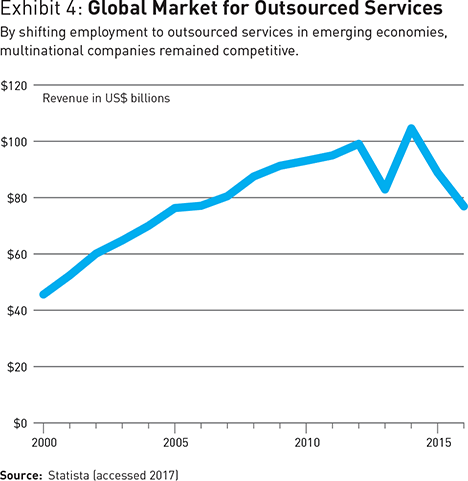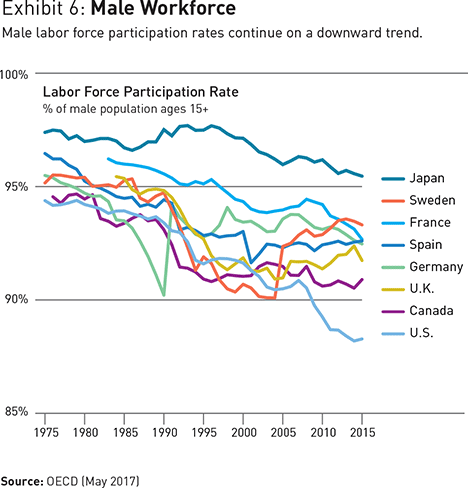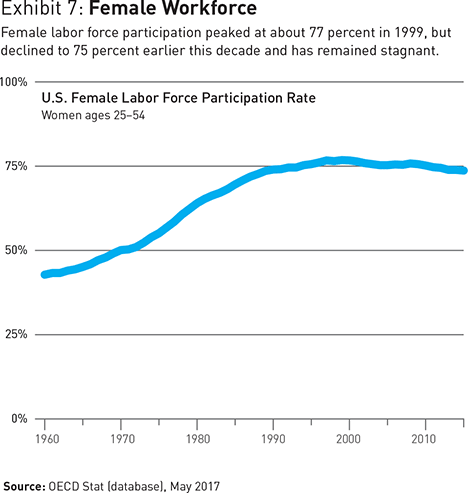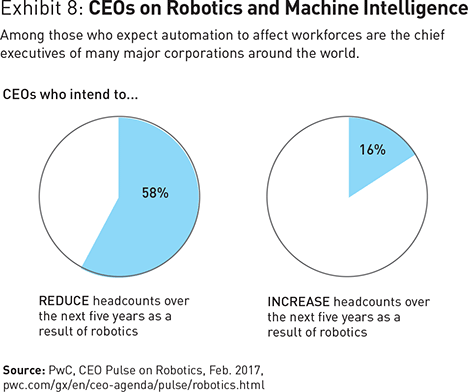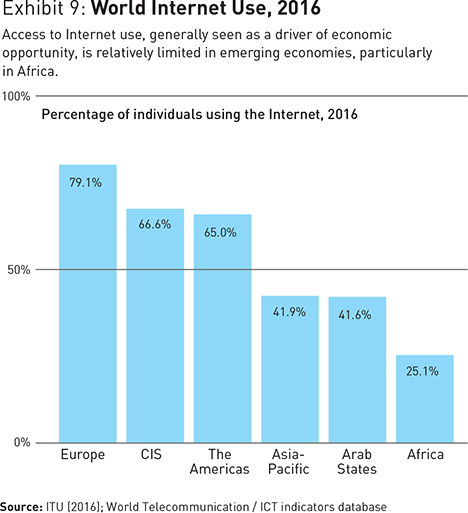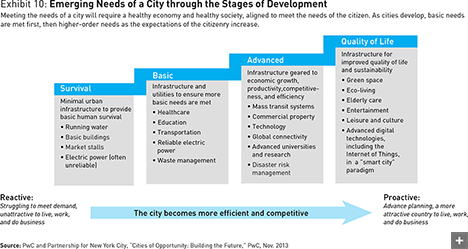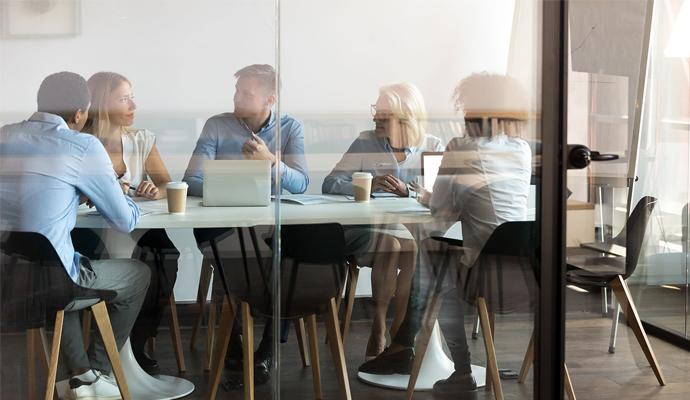Common purpose: Realigning business, economies, and society
Today’s economic and political upheavals reflect an ongoing misalignment between business and economies (on the one hand) and acceptable societal outcomes (on the other). There is still time to adjust, if we are willing to reexamine some long-held assumptions.

A version of this article appeared in the Autumn 2017 issue of strategy+business.
Underlying the bitter politics of our time is a simple, prevalent reality: Too many people feel that they are being left behind by a system unfairly stacked against them. For a number of generations, citizens in the world’s wealthiest nations perceived themselves as participants in a long chain of ever-increasing prosperity. Now many see themselves as worse off than their parents. They also believe their children’s lives will be worse than their own, and often with good reason. They resent the global financial system and perceive that its benefits are going only to a small minority of people — which does not include them.
These perceptions are now so widely shared that they add up to a political and economic malaise. This is not limited to the “populists” who are angry and active; they are prominent because of the role they have played in influencing major elections. No matter what your own political perspective may be, our times are marked by a fundamental loss of confidence: in the reliability and impact of economic growth; in the institutions of our interconnected world (and the trust people have in them); and in the apparent ability of government, business, and civil society to respond.
Citizens of wealthy nations long perceived themselves in a chain of ever-increasing prosperity. Now many are worse off than their parents.
Why is this happening? A wide variety of factors have been blamed: technology, globalization, economic and political theories (of all sorts), business, government, partisan gridlock, immigration, religion, and the influence of special interests. Members of the working and middle classes, the global elites against whom they are rebelling, and the new wave of populist political leaders challenging those elites have identified one another as the problem. But as long as the discussion focuses on separate culprits, it’s difficult to find a solution. The root cause is the relationship among a subset of these factors, and how they have emerged, interacted, and transformed over the past several decades.
In the period after World War II, three drivers of change served humanity well by typically delivering both economic growth and social progress over many years.
1. Globalization: the building out of worldwide economic institutions, facilitating the cross-border migration of people, goods, capital, and information, and ultimately driving significant increases in international trade
2. Technological advances: spurred by the computer and Internet, but also encompassing communications generally, biotech, and healthcare, leading ultimately to robotics and artificial intelligence
3. “Financialization”: a view of value based on financial metrics, primarily GDP at a macro level and shareholder value at a corporate level
Together these drivers and the institutions that embody them had an extraordinarily positive impact on society. They lifted billions of people out of poverty and raised the quality of life around the world in unprecedented ways. However, as the three drivers evolved, they began to accelerate and change, not only in their essential nature but especially in their compound effect. Each driver has influenced and reinforced the others, ultimately combining to cause a divergence between economic growth and social progress that has placed the current system under a significant strain.
How have we gotten here and what can we do to adjust our course? In this article, intended to solicit debate and inquiry, we examine the key drivers of change to help better understand their nature and the events that have surrounded them, and to contribute to discussion of how to bring business, economies, and society back into greater alignment.
The Long Growth Wave, 1945–89
With the end of World War II, a virtuous cycle began that lasted for nearly 45 years, and that continues to affect the way we think about business, economies, and society. The virtuous cycle represented an unprecedented alignment of economic growth with social progress, resulting from the three drivers: globalization, technological advances, and financialization.
One key element was triggered by the Marshall Plan, an initiative that gave loans and grants from the U.S. to other countries (totaling about US$13 billion between 1947 and 1951) and was intended to help rebuild Europe and Japan. The Marshall Plan went beyond funding; it established structural changes with an eye toward multinational interdependency. Its lessening of regulations and trade barriers was the first of many steps toward forming the European Union. Together with such measures as the Bretton Woods agreement of 1944, which established monetary exchange among nations, the plan laid the foundation for an increasingly global economy.
The result was sustained and significant economic growth, delivering first recovery and then social progress. Companies sold predominantly to their rapidly growing home markets, full of consumers making many purchases for the first time (most dramatically in the U.S., where the GI Bill helped create a large new group of professionals, composed of returning veterans). The economic engine worked exceptionally well and in alignment with the communities and societies within which it operated. Rising tides lifted all boats.
This was also a period of significant technological progress, leading to the 1965 formulation of Moore’s Law, which predicted continued exponential growth in computing power. Many of the technologies that made personal computers and the Internet possible began in the 1960s. Some, like packet switching and artificial intelligence, were prerequisites for today’s cloud computing–based platforms and Internet of Things infrastructure. The mobile phone, a version of which was introduced commercially by AT&T in 1946, would take almost six decades to develop into today’s smartphone, the fastest-selling gadget in history.
Meanwhile, a globally interconnected economy took shape, featuring increasing levels of international trade (see Exhibit 1). According to the World Trade Organization (in its 2008 World Trade Report), international exports grew more than 8 percent per year between 1950 and 1973. New markets opened up, communications and transportation technology improved, regions became more connected through trade agreements, and capital became more readily available through deregulation. Together these factors enabled companies to do more business abroad. As their home economies matured, they began to rely on far-flung markets for growth. Slowly at first, then with greater speed, multinational corporations (MNCs) introduced their wares around the world, led by consumer products and automobiles.
An unprecedented sharing of knowledge and talent across international boundaries spurred productivity and innovation, supported by the institutional framework that had been put in place after the war. This pattern of global economic growth is often taken for granted today, but at the time, it contributed to a general perception of progress and prosperity, with enough to go around. There was a sense that this progress, underpinned by healthy market economies trading with each other, was the natural order of things in the postwar world — at least for the citizens of those countries that globalization had reached.
At the same time, policymakers grew accustomed to using GDP as the primary measure of national success. Drawn from agricultural and manufacturing statistics, it did not directly capture quality of life, but this did not matter so long as GDP and social progress rose together. A society full of promise was a natural outcome, it seemed, of the burgeoning financial world.
Business leaders, for their part, gradually returned to the concept that a company’s main objective should be to maximize shareholder value. This had been the prevailing point of view before the 1930s (Henry Ford had famously lost a lawsuit in 1919 to shareholders who objected to his paying workers $5 per day). But during the Great Depression and the War, American companies had adopted the view that they should work “in the balanced best interests of all,” a phrase used in the 1953 General Electric annual report. Starting around 1970, economists such as Milton Friedman, Michael Jensen, and William Meckling argued that this multifaceted approach created inefficiency and waste. Management could make more intelligent decisions with the single financial goal of shareholder value; in the view of these economists, this would automatically lead to better decisions for employees, customers, creditors, and the community as well. This mind-set was further reinforced by CEOs such as GE’s Jack Welch and International Telephone and Telegraph’s Harold Geneen, who delivered constant profit increases by aggressive restructuring of underperforming assets.
It is important to touch upon the nature and purpose of the economy — because the assumptions that underpin both are often subject to debate. The economy is considered here to be the engine by which human needs (and desires) can be met through opportunities. This means that the effectiveness of the engine itself largely determines the degree to which needs will be met and opportunities will be realized. During this period, the economic engine was delivering as intended, underpinned by the three drivers. It supported business and economic success, measured in financial terms, on an ever more global scale. This enabled many people to prosper, their communities to thrive, and society more broadly to advance.
Accelerated Success and Misalignment, 1989–2008
How reasonable it seemed by 1989 to think that this virtuous cycle represented the natural order of things. Humanity appeared to be moving to a world without borders, in which virtually every major nation relied upon market economies to make life better at a societal level, and now in an increasingly interconnected fashion. Or as political philosopher Francis Fukuyama wrote in 1989, “What we may be witnessing is not just the end of the Cold War, or the passing of a particular period of postwar history, but the end of history as such.” The new political thinking, he said, “describes a world dominated by economic concerns, in which there are no ideological grounds for major conflict between nations, and in which, consequently, the use of military force becomes less legitimate.”
Later that year, on Nov. 9, the fall of the Berlin Wall suggested that Fukuyama was right. This was one of four significant factors in this period that caused the drivers of change to converge, accelerate, and transform not only their nature but also their combined impact on a global scale:
1. The fall of the Berlin Wall marked the start of a period in which every major country in the world adopted some form of market economy. The event also had a significant psychological impact. Market economies were plainly seen to have made better provision for their citizens than their major ideological competitors.
2. Deng Xiaoping’s southern tour in the spring of 1992 ensured that China would retain market-based economic reforms and international trade as its central economic strategy. This was to become the country’s focus during the next two decades.
3. The emergence of the commercial Internet provided the technological backbone to allow ever more efficient global supply chains and ever-faster transfer of information and money throughout the world. Businesses were disrupted at almost every level, as technology and the communications revolution facilitated truly global operating models for the first time.
4. The “big bang” of financial deregulation in the City of London in October 1986 contributed to the massive movement of capital over the next few decades. For the first time, a truly global financial system could emerge, abetted by the communications revolution, reinforcing and underpinned by the financial discipline of shareholder value.
Partly through the influence of these four events and partly as an extension of the previous two decades’ logic, the years between 1990 and 2010 were marked by a plethora of free trade agreements of one kind or another (see Exhibit 2). This helped streamline bureaucracies and spawned greater overall economic integration. Billions of potential workers and therefore consumers became accessible globally.
Over a short time, these developments brought about a significant change in how the three drivers all behaved. Previously, international trade had been dominated by countries with relatively equivalent wage rates, legal structures, and technological development. Now, the international trade system was connected to countries with massive populations, low wage rates, immature capital markets, and nascent market-based legal processes. This contributed to a form of trade that was quite different from that of the previous period. In particular, large-scale labor arbitrage — the movement of work from high-labor-cost countries to those with low labor costs — became commonplace, facilitated by financialization and technology.
Through the 1990s, the march of prosperity hastened (see Exhibit 3). Economic activity and global trade increased throughout much of the world while society continued to make great strides forward. People were living longer, poverty was being reduced, and the world was getting better.
Globalization moved rapidly beyond Europe and Japan to countries that previously had been largely left out. Asian tigers, Middle East oil producers, former Soviet bloc countries, and large emerging countries such as China and India all adopted market economies, making remarkable gains in economic well-being. In China alone, more than 600 million people were lifted out of poverty between 1990 and 2013. (Despite this progress, World Bank figures show that 10.7 percent of the world’s population lived on less than $1.90 a day in 2013.) India also began its 20-year transition from a largely subsistence economy to a global economic powerhouse, with an explosion of private companies. The rise of skilled and semi-skilled labor forces in these countries brought higher wages and greater levels of middle-class privilege to them, spreading wealth and opportunity more equitably around the world.
Continuing advances in digital technology reinforced this movement. The personal computer, the World Wide Web, and the mobile phone gave people unprecedented access to productivity, opportunity, global trade, and one another, generally irrespective of national boundaries. This new level of connectivity made it feasible for global companies to manage complex supply chains. The development of technologies, from the container ship to the global Internet, made it easier to communicate and ship goods. Goods no longer needed to be produced near consumers, and components no longer needed to be manufactured together. Manufacturing jobs began to migrate en masse to emerging economies, which at the same time experienced a surge in inflows from foreign direct investment.
In the mid-2000s, outsourcing services as well as products became increasingly common. The exporting of jobs expanded to include call center operations, software development, and secretarial and clerical work (see Exhibit 4). Technological and financial factors, such as the short-term imperatives of automated trading and the pressure for financial performance from shareholders, added incentives for companies to conduct labor arbitrage (and other forms of financial and environmental arbitrage) at an ever-larger scale.
These business decisions, shifting activities and employment from one part of the world to another, were rational. In fact, they represented the only way for an MNC to stay competitive. Collectively, on a huge scale over time, they contributed to huge global progress by spreading income and employment into new markets. But this also inevitably impacted the advanced economies that had often been the original homes of these now truly international businesses. Already high levels of unemployment in some communities were further raised by increases in automation, particularly in manufacturing. Although the economic engine was delivering as planned in macro terms, this unemployment was a sign that not everyone was benefiting and all was not well.
Global Progress, Local Disharmony
The Great Recession of the late 2000s exposed these weaknesses. The financial crisis itself was less a cause than an indicator, revealing a misalignment within the system as a whole that had been growing for years. In a more globalized, technology-enabled world, the recession’s impact was felt at unparalleled speed.
The two primary indicators of success for the previous 60 years, GDP at the macro level and shareholder value at the micro level, were now shown to be problematic. GDP did not reflect the negative effects of economic growth; people who dropped out of the job market, for example, were invisible to it. The GDP figures showed great global prosperity on average, while significant portions of the population were experiencing years of income stagnation and decline. GDP also ignored intangible factors such as environmental degradation, the low wage levels and insecurity associated with many of the remaining jobs, and the diminished quality of life in some communities.
Research conducted by World Bank economist Branko Milanović found that big earners and those in the bottom two-thirds of income levels (on average, globally) received major gains, but households in the 75th to 85th percentile of the global income distribution were scarcely better off economically in 2008 than they had been 20 years before. This group (represented by the dip in Exhibit 5) includes most of the middle class in industrialized countries.
The male labor force was particularly hurt (see Exhibit 6). “Tracking the Fortunes of the White Working Class,” an Economist article published in Feb. 2017, reported on a recent study in which 41 percent of white males with high school education or less between the ages of 25 and 65 in the United States were found to be unemployed, most no longer even seeking work. This group represents 23 percent of the American male workforce. In some communities affected by high unemployment, middle-aged white men have been getting sicker and dying in greater numbers than before, even as the world is living longer and healthier. These men are also more prone to suicide, drug overdoses, and alcohol-related liver disease than they used to be, with less access to medical care. Women too have been affected. Estimates show that although the gender gap on measures such as education has made significant progress, there is much less progress on economic measures. Global female labor force participation rates have declined since 1996, although less as a percentage of the original than is the case for men. In the U.S., for example, female prime age (25- to 54-year-olds) labor force participation peaked at about 77 percent in 1999, but declined to 75 percent earlier this decade and has remained stagnant (see Exhibit 7).
People who were affected by these challenges reacted in a variety of ways. Some moved from rural areas, while others took on additional employment when they could find it. Many households burdened themselves with unsustainable levels of debt to fund a standard of living that was no longer affordable, facilitated by lending practices that contributed to the financial crisis.
As for shareholder value, its sustained use as an indicator of commercial success had two significant consequences. First, companies retreated from their previously long-standing relationships with local communities. Second, businesses placed greater emphasis on short-term financial results. Since Alexis de Tocqueville published Democracy in America in 1835, economic success has been presumed to be linked to social progress. The shareholder–owner lived in the same town, went to the same market, and attended the same place of worship as the rest of the citizenry. Business success was intrinsically linked to the success of the community or society within which it operated. This linkage became far less important for a business operating on a global basis, which was not only expected but required to deliver competitive short-term financial returns, even as technology created an apparently endless range of competitive and disruptive threats and opportunities.
The nature of the three key drivers has now transformed so fundamentally that they will continue to behave differently. This has important implications for our future.
In our globalized world, economic growth has shifted to countries with their own unique histories that are very different from those of Europe and the United States. The E7 group of the largest emerging market economies (China, India, Indonesia, Brazil, Russia, Mexico, and Turkey) have begun to dislodge the G7 (the U.S., the U.K., France, Germany, Japan, Canada, and Italy) as the countries with the largest shares of world trade. Russia, Turkey, Saudi Arabia, and the UAE all have market economies combined with forms of governance that are different from those in the West. The most prominent example is China, which proved that it could foster market-style economic growth just as well as a democratic country could (or, perhaps, better). Enterprises in China made up 20 percent of the Fortune Global 500 in 2016.
The effects of globalization have been felt unequally by different countries. Thus, while still very interdependent, the world has begun to fracture along broad cultural lines — a point made prominently by political scientist Samuel Huntington. One consequence of this is that globalization is more difficult to sustain. Countries naturally tend to focus on those more like themselves. This is evident not only in the political arena, but also in the approach to business and the economy. More than one version of a market economy has emerged.
Technology has changed its trajectory as well. We are moving from an online world that has facilitated much greater human interaction to one that will enable things to communicate with each other, and decisions to be made with artificial intelligence. In a recent global survey of CEOs conducted by PwC (see Exhibit 8), the vast majority of respondents said robotics and machine intelligence would significantly remove labor from their workforce over the next few years. The scale of information flow and the speed of transmission have also added to the strain felt by existing institutions. These are not just Western issues; a labor glut is likely to appear in China and India as well. According to the International Federation of Robotics, quoted in the Economist in March 2015, the public and private sector in China purchased 20 percent of all the robots made in 2013.
Regions such as sub-Saharan Africa may be the hardest hit by the growing reliance on automation and robotics. They tend to have inadequate access to technology, particularly electricity and the Internet, and the further disadvantage of a late start (see Exhibit 9). By the time the African workforce is ready to adapt to industrialization, automation may have taken away industrial jobs that, in the past, have lifted other regions of the world out of poverty. Since many African countries have large youthful populations, the end result could be very challenging in civil terms, with the possibility of even larger movements of people, not just from Syria but migrating from a variety of Middle East and Central African countries.
Together, these trends have led to the erosion of trust in mainstream global institutions, including government, business, the media, education, and nongovernmental organizations (NGOs). The 2017 Edelman Trust Barometer survey found that only 15 percent of the general-population respondents believe the present system is working; 53 percent do not and 32 percent are uncertain. Edelman argues that the trust collapse has now become a systemic threat. The claim that “elites are out of touch” has struck a chord. This rising polarization could add fuel to nationalist and populist movements. This may in turn lead to greater protectionist policies, which could exacerbate the root problems discussed here.
Today we find ourselves at a crossroads. For decades, globalization, technology, and financialization worked as a system to create both economic growth and social progress, but retaining them in their present form is unsustainable. We cannot return to how things were, nor should we want to. We need to reframe the alignment of these forces, or face a challenging future. If we do not intervene, the risk is that many of the trends we see now will continue and even accelerate: slowing growth in advanced economies, continued erosion of the working and middle classes around the world, stagnant or declining pay to workers in advanced economies, unemployment in large sections of the world made worse by automation, Africa missing out on the benefits of globalization altogether, sustained harm to communities and our broader environment, and continued erosion of trust. These factors will feed increased political uncertainty and instability.
Addressing these issues will require realigning our economies and political systems so that they again better meet human needs. We have an opportunity to change our course and achieve a more positive future. This will require immense effort among a broad range of government, business, and community groups. None of these groups can solve these problems unilaterally. The solution will require an extensive engagement among all. The answers are not all clear, but there are some observations that we believe can help inform a way forward.
Observations for Achieving Realignment
As we reflect on this situation, it is critical not to lose sight of the progress and positive impact each of the three drivers has had. We should not throw the baby out with the bathwater. Well-managed market economies have consistently delivered economic growth and social progress more successfully than the alternatives, and can continue to do so.
A globalized world is a reality. Issues (and opportunities) will not respect national boundaries. Technology, disease, security, migration, ideas, and our environment are relevant for all countries; they require sustained engagement on a cross-border basis. GDP growth and financial performance are essential to provide the resources to address the needs of our broader society. And people will continue to demand the benefits of technology. We cannot romanticize about going back to a world before we were globally interdependent, financially intertwined, and technology enabled.
Instead, there is an urgent need to revisit the very purpose of the economy — an engine to match human needs and opportunities. At its best, an economy is a dynamic and evolving framework of rules, habits, agreements, behaviors, and practices that facilitates meeting the needs of people and their communities, and engages human skill and effort, as well as technology and capital, to do so. We also need to consider how emerging technologies can help us reimagine ways to meet human needs, those we have been incapable of addressing in a traditional manner.
It will be hard to bring about this change. In the first place, the three critical drivers have created an interdependent system that must be addressed in its entirety if we are going to alter our current course. Seventy years of success has created a highly interdependent web of regulation, business practices, and institutions based on assumptions about the proper form of globalization, financial metrics, and technology. Changing one strand of the web will not work; the others will act as a force of inertia. Any change needs to take place at a broader level — involving the whole system in which institutions are embedded. Only then can we influence both behaviors and outcomes so that they align with a reframed system.
In the second place, change entails managing a set of dualities. In the recent past we have tended to seek the answer in a choice between apparent opposites: one measure or many, globalization or localization, technology or people. Many of the observations below suggest that we need to take a more sophisticated approach by reflecting this duality. For example, human needs must be met — progress must be made — on a local basis, albeit in a global context. This duality — global and local — applies to the other drivers also.
Taking all this into account, here are some observations as a starting point for discussion:
1. Economic growth is not universally benign. One fundamental assumption of economic theory for at least the last 70 years has been that social progress follows economic growth as traditionally measured. We must now recognize that this is not necessarily true. We must intentionally target acceptable societal outcomes, leveraging market economies to do so.
2. Both financial (GDP) and societal target outcomes should be explicitly framed. This necessitates a key role for government and citizens in articulating goals that reflect the needs of local communities, cities, and regions, as well as countries as a whole. Not all needs are equal. Basic human needs must be prioritized, consistent with the concept of a hierarchy of needs.
3. We need to devote more energy to creating thriving communities. Human needs are best identified and managed at a local level. Cities, towns, and villages are the places where social progress and economic success most naturally meet. We need to create conditions for these communities to thrive, with business as a key part of the ecosystem. Exhibit 10 presents a basic model of the ongoing development of an urban community. This will require some rethinking of both the role of the nation-state and of globalization. We need to consider how to operate in a world of increasing global connectedness while fostering local initiative.
4. We need to leverage the full potential of market economies in a globalized environment. Better outcomes are needed at all levels: regional, national, metropolitan, and local community levels. A key role for government is to create the conditions necessary for localities to address opportunities and challenges effectively and to create the institutional framework that will encourage the economic engine to match human needs and opportunities.
5. Governments and businesses should engage to develop policies that align business outcomes with broader objectives — especially in the context of global businesses operating locally, reflecting their license to operate and broader purpose. The very wealthy also have a role to play in deploying their capital and influence to promote broader societal success.
6. Single measures of success do not accurately represent complex systems for long. Financial performance is an essential element underpinning any market economy, but it cannot be the only measure of performance or success in a globalized economy. Other, broader measures, reflecting target outcomes in societal terms, must also be considered. We need to focus on managing the duality of GDP growth (at a national level) and shareholder returns (at a firm level) along with meeting a broader set of societal and personal needs. Reporting at both a macroeconomic and corporate level must reflect financial and societal objectives.
7. “Average” success is not enough. It is not sufficient to target overall progress for a country or a region or the world, because results can vary significantly from one community or one country to the next.
8. Technology is indifferent to its impact on people. There is a growing risk that technology will harm the livelihoods and well-being of an ever-larger swathe of people, whether through displacement of jobs, due to robotics and machine intelligence, social isolation, or disruption of communities. This need not be true. Emerging technologies can help meet human needs in new ways that create new industries and unforeseen types of new jobs. This will require an evolution of global and local financial and economic systems to create the conditions that will allow this to happen. In addition, technological change is most likely to be adopted effectively in those parts of the world already advantaged over the last few decades. As a result, finding ways to support the growth of the most disadvantaged areas becomes even more critical.
9. We need to focus on education to deliver the right skills for the future. This will require direct engagement between governments and businesses to match people’s needs with opportunities, particularly in a technology-enabled environment.
Anyone reading this article is a citizen, and is likely worried about the future of their country and the ones they are close to. Given the pressing nature of the issues raised here, we hope that readers will reflect on the diagnosis and observations we suggest and engage their organizations and communities to address the growing challenges. It is important to recognize how frameworks developed over the last 70 years have in some circumstances led to troubling consequences. We urge you to focus on the issues as they exist now and some of the above observations about how to address them.
A healthy economy needs a healthy society, just as a healthy society needs a healthy economy. This is one of the defining lessons of the period since the end of World War II. It has long served business and policymakers well to create the conditions for this commonality of interest. Now is the time for the system to be realigned, once again as throughout human history, around greater commonality of purpose.
Reprint No. 17307
Author profiles:
- Colm Kelly is the global tax and legal services leader for the PwC network. He is also the chair of the Foundation for Fiscal Studies, an independent nonprofit dedicated to promoting study and discussion of issues related to fiscal policy. He is based in Dublin, Ireland.
- Blair Sheppard is global leader of strategy and leadership development for the PwC network. He is also professor emeritus and dean emeritus of Duke University’s Fuqua School of Business. He is based in Durham, N.C.
- Also contributing to this article were PwC US partner Michael Morrow and PwC UK directors Ceri-Ann Droog and Bethan Grillo.





